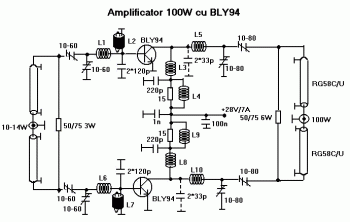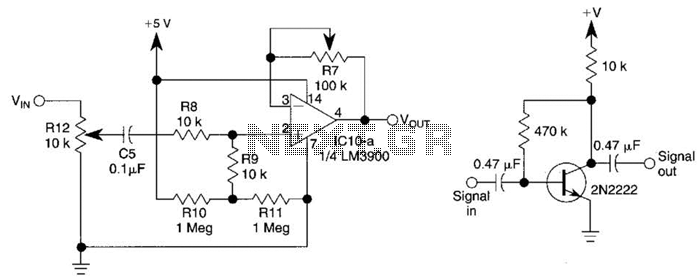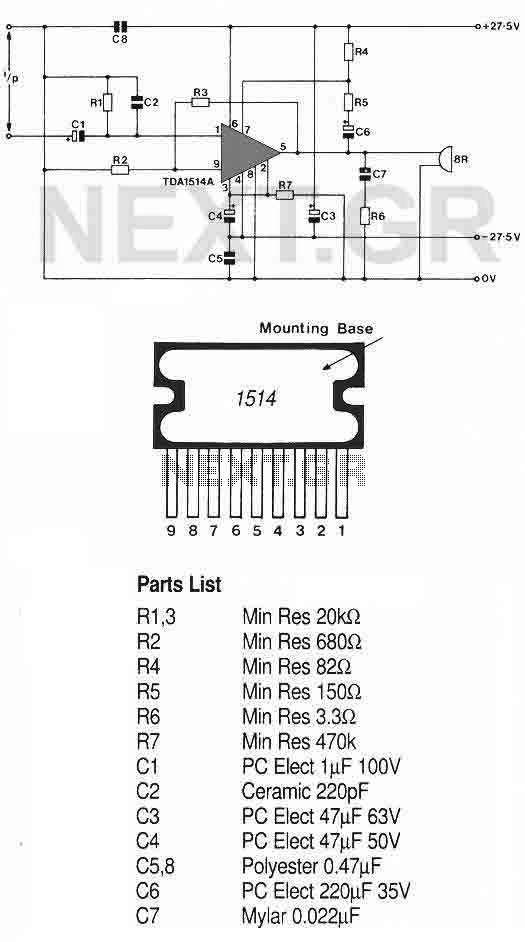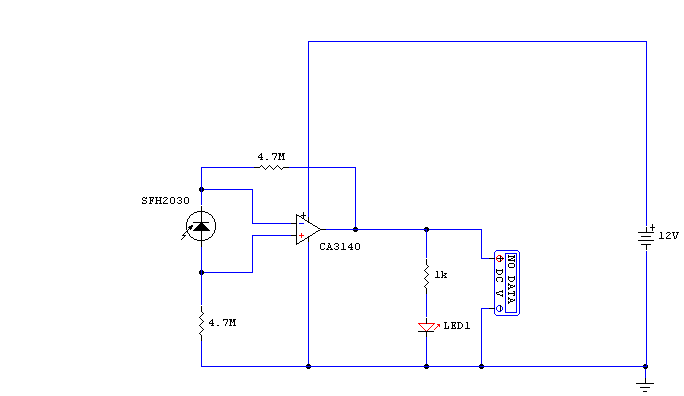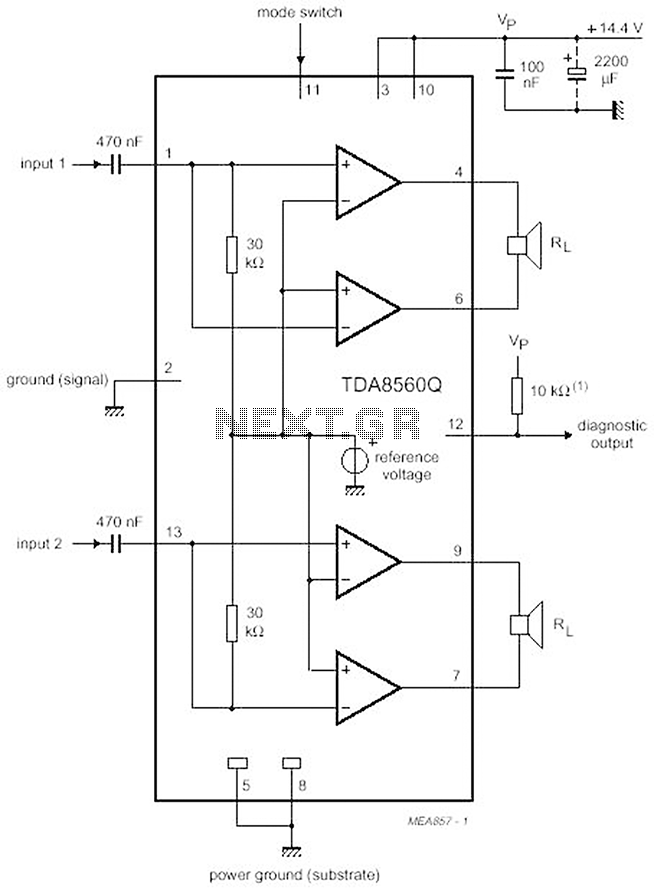
Audio and amplifier circuits
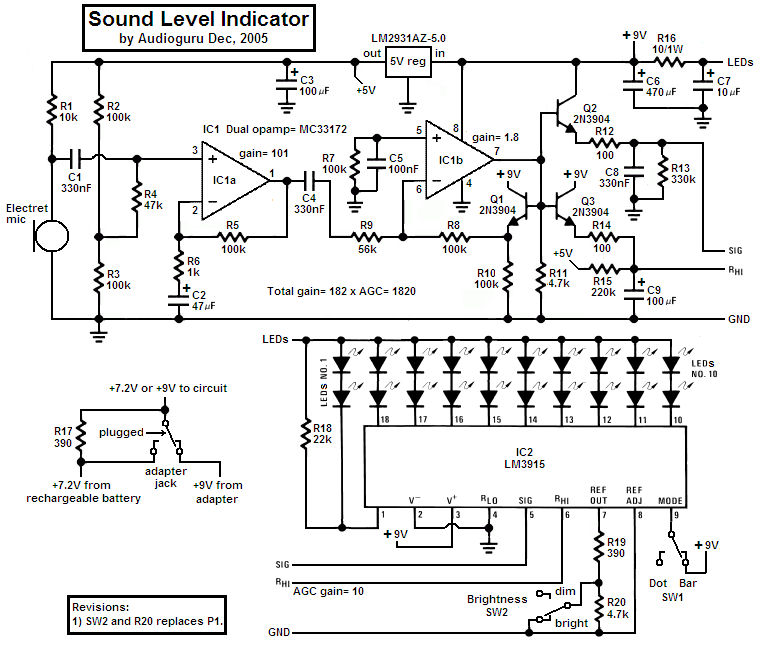
This high-Q notch filter operates at 60 Hz and is based on the "Twin-T" design. It creates a significant notch in the response curve at approximately 59.7 Hz, effectively eliminating 60 Hz hum and noise from audio recordings or live performances. The response level is reduced to over -60 dB at the center frequency. Additionally, there is a note player circuit capable of producing 8-note tunes at any desired speed, with the notes selected via 8 trim pots and speed controlled by a ninth pot. The document also describes three adjustable notch filter configurations suitable for use in small preamplifier or amplifier projects to filter out hum at 50 Hz (European) or 60 Hz. Furthermore, an audio amplifier output relay delay circuit is designed to control a relay that activates the speaker output after a delay of approximately 5 seconds post power-up, preventing an undesirable "thump" sound from the speakers. Other audio circuits mentioned include a 2 Watt amplifier utilizing discrete components, an ECM microphone preamplifier for high-quality electret microphones, tone controls, a stereo line driver, an 8 Watt TDA2030 amplifier, an audio notch filter for frequencies ranging from 100 Hz to 10 kHz, a 6-input mixer with 3 microphone and 3 line inputs, a hi-fi preamplifier, a peak reading audio level meter, and a music-to-light modulator that adjusts light intensity in response to audio input. Lastly, a siren circuit is described, which simulates an emergency siren using a two-transistor flasher with frequency modulation applied to the base of the first transistor.
The high-Q notch filter described utilizes the "Twin-T" configuration, a well-known design in audio signal processing. This type of filter is particularly effective for eliminating specific frequency noise, making it ideal for applications in audio engineering where 60 Hz hum is prevalent, such as in environments with fluorescent lighting or other electromagnetic interference sources. The notch filter achieves a depth of attenuation that exceeds -60 dB at its center frequency of 59.7 Hz, ensuring that unwanted noise is significantly reduced, thereby improving audio clarity.
The 8-note tune player circuit is an interesting application that allows for creative sound generation. The use of trim pots for note selection provides flexibility, enabling users to customize the musical output according to their preferences. The speed control pot further enhances this circuit's versatility, allowing for dynamic performance variations.
In the context of audio amplification, the adjustable notch filters can be integrated into preamplifier or amplifier designs to mitigate hum from power sources, enhancing overall sound quality. The ability to adjust these filters for either 50 Hz or 60 Hz makes them suitable for international applications, accommodating different electrical standards.
The audio amplifier output relay delay circuit is a critical feature in preventing speaker damage and listener discomfort caused by transient sounds during power-up. By implementing a delay mechanism, the circuit ensures that the speakers are only activated after a safe period, allowing the amplifier to stabilize.
Additional circuits mentioned, such as the 2 Watt amplifier and the ECM microphone preamplifier, contribute to a comprehensive audio processing toolkit. The 2 Watt amplifier, designed with discrete components, aims to minimize distortion, while the ECM preamplifier enhances the performance of electret microphones, ensuring high-quality audio capture.
The inclusion of a music-to-light modulator indicates an interest in multimedia applications, where audio signals can be used to control lighting effects, creating an engaging experience for users. The siren circuit, with its frequency modulation feature, showcases the potential for creating alert systems or sound effects in various applications.
Overall, these circuits represent a diverse range of audio processing and amplification solutions, suitable for both professional and hobbyist applications in electronics.60-Hz, This high-Q notch filter is based on the "Twin-T" design. It produces a very deep notch in the response curve at about 59. 7 Hz. This is useful to remove 60-Hz hum and noise from audio recordings or live performances. Response is down over -60db at the center point, pdf file 8 Note Tune Player This neat little circuit can play 8 note tunes at any speed you want. You select the notes with 8 trim pots. The speed in selected through a ninth pot Adjustable 60Hz Filter On this page three adjustable notch filters configurations are shown. They can be used in your small pre-amp or amplifier project to filter out any HUM at 50 Hz ( European ) or 60Hz Audio amplifier output relay delay the purpose of this circuit is to control the relay which turns on the speaker output relay in the audio amplifier.
The idea of the circuit is wait around 5 seconds ofter the power up until the spakers are switched to the amplfier output to avoid annoying "thump" sound from the speakers Audio circuits audio circuits, 2 Watt Amplifier A low distortion amplifier using discrete components, ECM Mic Preamplifier A high quality preamp for electret mic inserts, Tone Controls, Stereo Line Driver, TDA2030 8 Watt amplifier, Audio Notch Filter For audio frequencies 100Hz - 10KHz, 6 Input Mixer 3 Mic inputs, 3 Line Inputs, Hi-Fi Pramplifier, Peak Reading Audio Level Meter, Doorphone Intercom Music to light modulator A music-to-light modulator is a circuit which controls the intensity of one or more lights in response to an audio input, MOC3021, pdf file Siren circuit Emergency Siren Simulator, The heart of the circuit is the two transistor flasher with frequency modulation applied to the base of the first transistor, . 🔗 External reference
The high-Q notch filter described utilizes the "Twin-T" configuration, a well-known design in audio signal processing. This type of filter is particularly effective for eliminating specific frequency noise, making it ideal for applications in audio engineering where 60 Hz hum is prevalent, such as in environments with fluorescent lighting or other electromagnetic interference sources. The notch filter achieves a depth of attenuation that exceeds -60 dB at its center frequency of 59.7 Hz, ensuring that unwanted noise is significantly reduced, thereby improving audio clarity.
The 8-note tune player circuit is an interesting application that allows for creative sound generation. The use of trim pots for note selection provides flexibility, enabling users to customize the musical output according to their preferences. The speed control pot further enhances this circuit's versatility, allowing for dynamic performance variations.
In the context of audio amplification, the adjustable notch filters can be integrated into preamplifier or amplifier designs to mitigate hum from power sources, enhancing overall sound quality. The ability to adjust these filters for either 50 Hz or 60 Hz makes them suitable for international applications, accommodating different electrical standards.
The audio amplifier output relay delay circuit is a critical feature in preventing speaker damage and listener discomfort caused by transient sounds during power-up. By implementing a delay mechanism, the circuit ensures that the speakers are only activated after a safe period, allowing the amplifier to stabilize.
Additional circuits mentioned, such as the 2 Watt amplifier and the ECM microphone preamplifier, contribute to a comprehensive audio processing toolkit. The 2 Watt amplifier, designed with discrete components, aims to minimize distortion, while the ECM preamplifier enhances the performance of electret microphones, ensuring high-quality audio capture.
The inclusion of a music-to-light modulator indicates an interest in multimedia applications, where audio signals can be used to control lighting effects, creating an engaging experience for users. The siren circuit, with its frequency modulation feature, showcases the potential for creating alert systems or sound effects in various applications.
Overall, these circuits represent a diverse range of audio processing and amplification solutions, suitable for both professional and hobbyist applications in electronics.60-Hz, This high-Q notch filter is based on the "Twin-T" design. It produces a very deep notch in the response curve at about 59. 7 Hz. This is useful to remove 60-Hz hum and noise from audio recordings or live performances. Response is down over -60db at the center point, pdf file 8 Note Tune Player This neat little circuit can play 8 note tunes at any speed you want. You select the notes with 8 trim pots. The speed in selected through a ninth pot Adjustable 60Hz Filter On this page three adjustable notch filters configurations are shown. They can be used in your small pre-amp or amplifier project to filter out any HUM at 50 Hz ( European ) or 60Hz Audio amplifier output relay delay the purpose of this circuit is to control the relay which turns on the speaker output relay in the audio amplifier.
The idea of the circuit is wait around 5 seconds ofter the power up until the spakers are switched to the amplfier output to avoid annoying "thump" sound from the speakers Audio circuits audio circuits, 2 Watt Amplifier A low distortion amplifier using discrete components, ECM Mic Preamplifier A high quality preamp for electret mic inserts, Tone Controls, Stereo Line Driver, TDA2030 8 Watt amplifier, Audio Notch Filter For audio frequencies 100Hz - 10KHz, 6 Input Mixer 3 Mic inputs, 3 Line Inputs, Hi-Fi Pramplifier, Peak Reading Audio Level Meter, Doorphone Intercom Music to light modulator A music-to-light modulator is a circuit which controls the intensity of one or more lights in response to an audio input, MOC3021, pdf file Siren circuit Emergency Siren Simulator, The heart of the circuit is the two transistor flasher with frequency modulation applied to the base of the first transistor, . 🔗 External reference
Warning: include(partials/cookie-banner.php): Failed to open stream: Permission denied in /var/www/html/nextgr/view-circuit.php on line 713
Warning: include(): Failed opening 'partials/cookie-banner.php' for inclusion (include_path='.:/usr/share/php') in /var/www/html/nextgr/view-circuit.php on line 713
